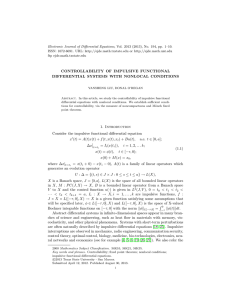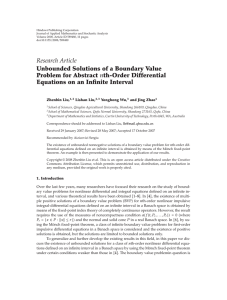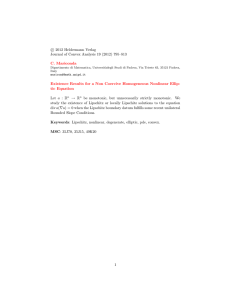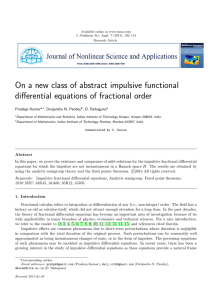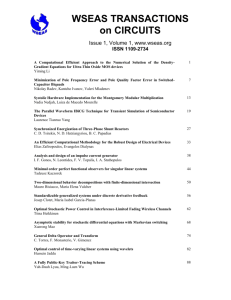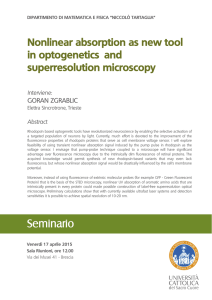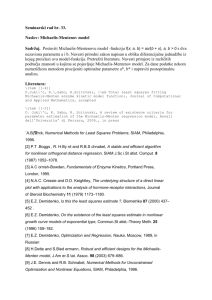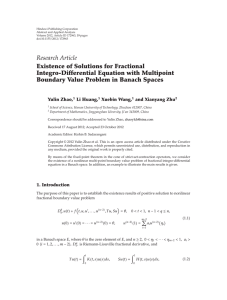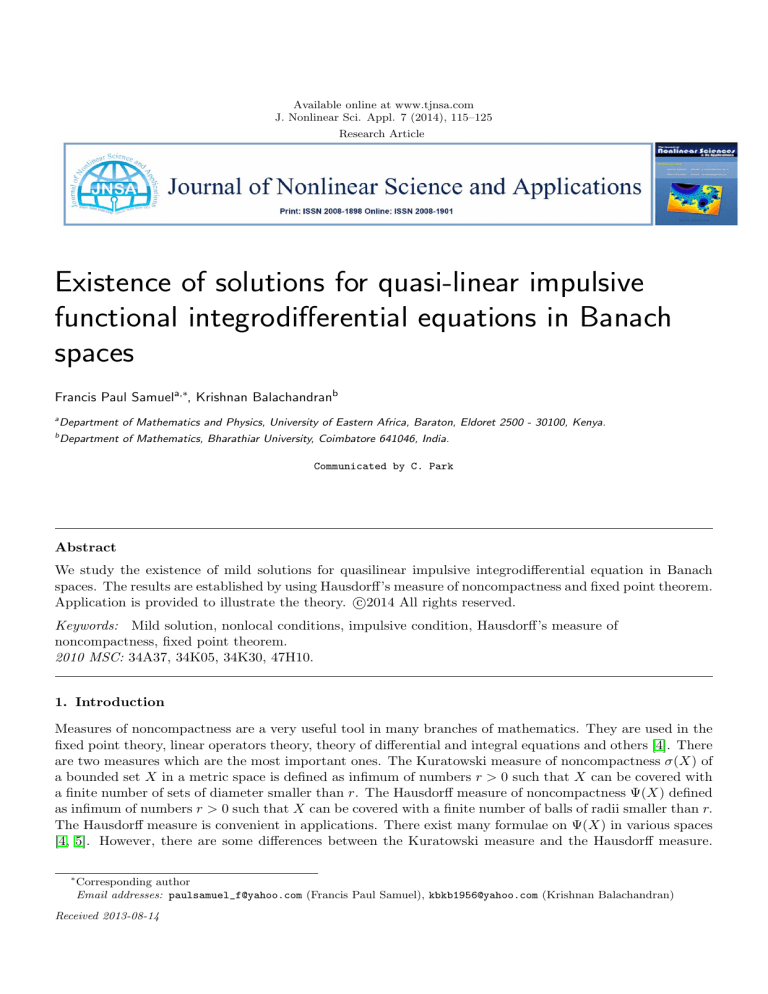
Available online at www.tjnsa.com
J. Nonlinear Sci. Appl. 7 (2014), 115–125
Research Article
Existence of solutions for quasi-linear impulsive
functional integrodifferential equations in Banach
spaces
Francis Paul Samuela,∗, Krishnan Balachandranb
a
Department of Mathematics and Physics, University of Eastern Africa, Baraton, Eldoret 2500 - 30100, Kenya.
b
Department of Mathematics, Bharathiar University, Coimbatore 641046, India.
Communicated by C. Park
Abstract
We study the existence of mild solutions for quasilinear impulsive integrodifferential equation in Banach
spaces. The results are established by using Hausdorff’s measure of noncompactness and fixed point theorem.
Application is provided to illustrate the theory. c 2014 All rights reserved.
Keywords: Mild solution, nonlocal conditions, impulsive condition, Hausdorff’s measure of
noncompactness, fixed point theorem.
2010 MSC: 34A37, 34K05, 34K30, 47H10.
1. Introduction
Measures of noncompactness are a very useful tool in many branches of mathematics. They are used in the
fixed point theory, linear operators theory, theory of differential and integral equations and others [4]. There
are two measures which are the most important ones. The Kuratowski measure of noncompactness σ(X) of
a bounded set X in a metric space is defined as infimum of numbers r > 0 such that X can be covered with
a finite number of sets of diameter smaller than r. The Hausdorff measure of noncompactness Ψ(X) defined
as infimum of numbers r > 0 such that X can be covered with a finite number of balls of radii smaller than r.
The Hausdorff measure is convenient in applications. There exist many formulae on Ψ(X) in various spaces
[4, 5]. However, there are some differences between the Kuratowski measure and the Hausdorff measure.
∗
Corresponding author
Email addresses: paulsamuel_f@yahoo.com (Francis Paul Samuel), kbkb1956@yahoo.com (Krishnan Balachandran)
Received 2013-08-14
F. P. Samuel, K. Balachandran, J. Nonlinear Sci. Appl. 7 (2014), 115–125
116
One of these differences is that σ(X) depends on the set X only, while Ψ(X) also depends on the space in
which X is included. Let E be a Banach space and F be a subspace of E. Let ΨE (X), ΨF (X), σE (X), σF (X)
denote Hausdorff and Kuratowski measures in spaces E, F, respectively. Then, for any bounded X ⊂ F we
have
ΨE (X) ≤ ΨF (X) ≤ σF (X) = σE (X) ≤ 2ΨE (X).
The notion of a measure of noncompactness turns out to be a very important and useful tool in many
branches of mathematical analysis. The notion of a measure of weak compactness was introduced by De Blasi
[10] and was subsequently used in numerous branches of functional analysis and the theory of differential
and integral equations. Several authors have studied the measures of noncompactness in Banach spaces
[4, 5, 14, 1, 13, 15, 22].
On the other hand, the study of the impulsive differential equations has attract a great deal of attention.
Many evolution processes are characterized by the fact that at certain moments of time they experience
a change of state abruptly. These processes are subject to short-term perturbations whose duration is
negligible in comparison with the duration of the process. Consequently, it is natural to assume that these
perturbations act instantaneously, that is, in the form of impulses. It is known, for example, that many
biological phenomena involving thresholds, bursting rhythm models in medicine and biology, optimal control
model in economics, pharmacokinetics and frequency modulated systems, do exhibit impulsive effects. The
theory of impulsive differential equations is an important branch of differential equations have studied by
many authors [16, 19, 20, 21].
The existence of solution to evolution equations with nonlocal conditions in Banach space was studied first
by Byszewski [7, 8]. Byszewski and Lakshmikanthan [9] proved an existence and uniqueness of solutions of a
nonlocal Cauchy problem in Banach spaces. Ntouyas and Tsamatos [23] studied the existence for semilinear
evolution equations with nonlocal conditions. The problem of existence of solutions of evolution equations
in Banach space has been studied by several authors [3, 12, 24]. This article is motivated by the results of
[4, 14, 19, 3, 12, 11].
In this paper, we consider the quasilinear integrodifferential equations with impulsive and nonlocal
condition of the form
Z t
0
u (t) + A(t, u(t))u(t) = f (t, u(t)) +
g(t, s, u(s))ds, t ∈ [0, b],
t 6= ti
(1.1)
0
u(0) + h(u) = u0
∆u(ti ) = Ii (u(ti )),
(1.2)
i = 1, 2, 3, . . . , n, 0 < t1 < t2 <, . . . tn < b,
(1.3)
where A : [0, b] × X → X are continuous functions in Banach space X, u0 ∈ X, f : [0, b] × X → X,
−
g : Ω × X → X, h : PC([0, b]; X) → X and ∆u(ti ) = u(t+
i ) − u(ti ) constitutes an impulsive condition. Here
Ω = {(t, s) : 0 ≤ s ≤ t ≤ b}.
2. Preliminaries
Let X be a Banach space with norm ||·||. Let PC([0, b]; X) consist of functions u from [0, b] into X, such that
u(t) is continuous at t 6= ti and left continuous at t = ti and the right limit u(t+
i ) exists for i = 1, 2, 3, · · · , n.
Evidently PC([0, b]; X) is a Banach space with the norm
kukPC = sup ku(t)k,
t∈[0,b]
and denoted L([0, b]; X) by the space of X-valued Bochner integrable functions on [0, b] with the form
Z
kukL =
b
ku(t)kdt.
0
F. P. Samuel, K. Balachandran, J. Nonlinear Sci. Appl. 7 (2014), 115–125
117
The Hausdorff’s measure of noncompactness ΨY is defined by
Ψ(B) = inf {r > 0, B can be covered by finite number of balls with radii r}
for bounded set B in a Banach space Y .
Lemma 2.1 ([4]). Let Y be a real Banach space and B, E ⊆ Y be bounded, with the following properties:
(i)
(ii)
(iii)
(iv)
(v)
(vi)
(vii)
B is precompact if and only if ΨX (B) = 0.
ΨY (B) = ΨY (B̄) = ΨY (conB), where B̄ and conB mean the closure and convex hull of B respectively.
ΨY (B) ≤ ΨY (E), where B ⊆ E.
ΨY (B + E) ≤ ΨY (B) + ΨY (E), where B + E = {x + y : x ∈ B, y ∈ E}
ΨY (B ∪ E) ≤ max{ΨY (B), ΨY (E)}.
ΨY (λB) ≤ |λ|ΨY (B) for any λ ∈ R.
If the map F : D(F) ⊆ Y → Z is Lipschitz continuous with constant r, then ΨZ (FB) ≤ rΨY (B) for
any bounded subset B ⊆ D(F), where Z be a Banach space.
(viii) ΨY (B) = inf {dY (B, E); E ⊆ Y is precompact} = inf {dY (B, E); E ⊆ Y is finite valued}, where
dY (B, E) means the nonsymmetric (or symmetric) Hausdorff distance between B and E in Y .
+∞
(ix) If {WT
n }n=1 is decreasing sequence of bounded closed nonempty subsets of Y and limn→∞ ΨY (Wn ) = 0,
+∞
then n=1 Wn is nonempty and compact in Y.
The map F : W ⊆ Y → Y is said to be a ΨY -contraction if there exists a positive constant r < 1 such
that ΨY (F(B)) ≤ rΨY (B) for any bounded closed subset B ⊆ W, where Y is a Banach space.
Lemma 2.2 (Darbo-Sadovskii [4]). If W ⊆ Y is bounded closed and convex, the continuous map F : W → W
is a ΨY -contraction, the map F has atleast one fixed point in W.
We denote by Ψ the Hausdorff ’s measure of noncompactness of X and also denote Ψc by the Hausdorff ’s
measure of noncompactness of PC([0, b]; X).
Before we prove the existence results, we need the following Lemmas.
Lemma 2.3 ([4]). If W ⊆ PC([0, b]; X) is bounded, then Ψ(W(t)) ≤ Ψc (W) for all t ∈ [0, b], where W(t) =
{u(t); u ∈ W} ⊆ X. Furthermore if W is equicontinuous on [a, b], then Ψ(W(t)) is continuous on [a, b] and
Ψc (W) = sup{Ψ(W(t)), t ∈ [a, b]}.
1
∞
Lemma 2.4 ([17, 18]). If {un }∞
n=1 ⊂ L ([a, b]; X) is uniformly integrable, then the function Ψ({un (t)}n=1 )
is measurable and
∞ Z t
Z t
≤2
Ψ({un (s)}∞
(2.1)
Ψ
un (s)ds
n=1 )ds.
0
0
n=1
Lemma 2.5 ([4]). If W ⊆ PC([0, b]; X) is bounded and equicontinuous, then Ψ(W(t)) is continuous and
Z t
Z t
Ψ( W(s)ds) ≤
Ψ(W(s))ds.
0
for all t ∈ [0, b], where
Rt
0
W(s)ds = {
Rt
0
(2.2)
0
u(s)ds; u ∈ W}.
The C0 semigroup Uu (t, s) is said to be equicontinuous if (t, s) → {Uu (t, s)u(s) : u ∈ B} is equicontinuous
for t > 0 for all bounded set B in X. The following lemma is obvious.
Lemma 2.6. If the evolution family {Uu (t, s)}0≤s≤t≤b is equicontinuous and η ∈ L([0, b]; R+ ), then the set
Rt
{ 0 Uu (t, s)u(s)ds, ||u(s)|| ≤ η(s) for a.e s ∈ [0, b] is equicontinuous for t ∈ [0, b].
F. P. Samuel, K. Balachandran, J. Nonlinear Sci. Appl. 7 (2014), 115–125
118
From [3], we know that for any fixed u ∈ PC([0, b]; X) there exist a unique continuous function Uu :
[0, b] × [0, b] → B(X) defined on [0, b] × [0, b] such that
Z t
Au (w)Uu (w, s)dw,
(2.3)
Uu (t, s) = I +
s
where B(X) denote the Banach space of bounded linear operators from X to X with the norm ||F|| =
sup{||Fu|| : ||u|| = 1}, and I stands for the identity operator on X, Au (t) = A(t, u(t)), we have
Uu (t, t) = I, Uu (t, s)Uu (s, r) = Uu (t, r), (t, s, r) ∈ [0, b] × [0, b] × [0, b],
∂Uu (t, s)
= Au (t)Uu (t, s) for almost all t, s ∈ [0, b]
∂t
3. The Existence of Mild Solution
Definition 3.1. A function u ∈ PC([0, b] : X) is said to be a mild solution of (1.1) - (1.3) if it satisfies the
integral equation
Z t
Z s
h
i
u(t) = Uu (t, 0)u0 − Uu (t, 0)h(u) +
Uu (t, s) f (s, u(s)) +
g(s, τ, u(τ ))dτ ds
0
0
X
+
Uu (t, ti )Ii (u(ti )), 0 ≤ t ≤ b.
(3.1)
0<ti <t
In this paper, we denote M0 = sup{kUu (t, s)k : (t, s) ∈ [0, b] × [0, b]} for all u ∈ X. Without loss of
generality, we let u0 = 0. Assume the following conditions:
(H1 ) The evolution family {Uu (t, s)}0≤s≤t≤b generated by A(t, u(t)) is equicontinuous and ||Uu (t, s)|| ≤ M0
for almost t, s ∈ [0, b].
(H2 ) (a) The function h : PC([0, b] × X → X is continuous and compact.
(H3 )
(b) There exist N0 > 0 such that ||h(u)|| ≤ N0 for all u ∈ PC([0, b]; X).
(i) The nonlinear function f : [0, b] × X → X satisfies the Caratheodory-type conditions; i.e., f (·, u)
is measurable for all u ∈ X and f (t, ·) is continuous for a.e t ∈ [a, b].
(ii) There exists a function α ∈ L([0, b]; R+ ) such that for every u ∈ X, we have
kf (t, u)k ≤ α(t)(1 + kuk)
a.e t ∈ [0, b].
(iii) There exists a function k1 ∈ L([0, b]; R+ ) such that, for every bounded D ⊂ X, we have
Ψ(f (t, D)) ≤ k1 (t)Ψ(D)
(H4 )
a.e t ∈ [0, b].
(i) The nonlinear function g : [0, b] × [0, b] × X → X satisfies the Caratheodory-type conditions; i.e.,
g(·, ·, u) is measurable for all u ∈ X and g(t, s, ·) is continuous for a.e t ∈ [a, b].
(ii) There exist two functions β1 ∈ L([0, b]; R+ ) and β2 ∈ L([0, b]; R+ ) such that for every u ∈ X, we
have
kg(t, s, u(s))k ≤ β1 (t)β2 (s)(1 + ku(s)k)
a.e t ∈ [0, b].
(iii) There exists a function k2 ∈ L([0, b]; R+ ) such that, for every bounded D ⊂ X, we have
Ψ(g(t, s, D)) ≤ k2 (t)k3 (s)Ψ(D)
Rt
a.e t ∈ [0, b]. Assume that the finite bound of 0 k2 (s)ds is G0 .
F. P. Samuel, K. Balachandran, J. Nonlinear Sci. Appl. 7 (2014), 115–125
119
(H5 ) For every t ∈ [0, b] and there exist positive constants N1 and N2 , the scalar equation
n
hZ t
i
X
[α(s) + C0 β2 (s)](1 + m(s))ds +
m(t) = M0 N1 + M0 N2
di .
0
i=1
(H5 ) Ii : X → X is continuous. There exists a constant di > 0 i = 1, 2, 3, . . . , n such that
n
X
kIi (u(ti ))k ≤
di , where, i = 1, 2, 3, · · · , n.
i=1
For any bounded subset D ⊂ X, and there is a constant li > 0 such that
Ψ(Ii (D)) ≤
n
X
li Ψ(D), i = 1, 2 · · · , n.
i=1
Theorem 3.2. Assumptions (H1 ) − (H5 ) holds, then the impulsive nonlocal problem (1.1) - (1.3) has at
least one mild solution.
Proof. Let m(t) be a solution of the scalar equation
n
hZ t
i
X
m(t) = M0 N0 + M0
[α(s) + C0 β2 (s)](1 + m(s))ds +
di .
0
(3.2)
i=1
Rt
Let us assume that the finite bound of 0 β1 (s)ds is C0 for t ∈ [0, b].
Consider the map F : PC([0, b]; X) → PC([0, b]; X) defined by
Z t
Z s
h
i
(Fu)(t) = Uu (t, 0)h(u) +
Uu (t, s) f (s, u(s)) +
g(s, τ, u(s))dτ ds
0
0
X
+
Uu (t, ti )Ii (u(ti ))
(3.3)
0<ti <t
for all u ∈ PC([0, b]; X). Let us take W0 = {u ∈ PC([0, b]; X), ||u(t)|| ≤ m(t) for all t ∈ [0, b]}. Then
W0 ⊆ PC([0, b]; X) is bounded and convex.
We define W1 = conK(W0 ), where con means the closure of the convex hull in PC([0, b]; X). As Uu (t, s)
is equicontinuous, h is compact and W0 ⊆ PC([0, b]; X) is bounded, due to Lemma 2.6 and using the
assumptions, W1 ⊆ PC([0, b]; X) is bounded closed convex nonempty and equicontinuous on [0, b]. For any
u ∈ F(W0 ), we know
Z t
Z s
h
i
ku(t)k ≤ kUu (t, 0)h(u)k +
kUu (t, s) f (s, u(s)) +
g(s, τ, u(s))dτ kds
0
0
X
+
kUu (t, ti )Ii (u(ti ))k
0<ti <t
≤ M0 N0 + M0
t
hZ
s
||f (s, u(s))||ds +
0
Z
Z tZ
0
n
i
X
||g(s, τ, u(τ ))||dτ ds + M0
kIi (u(ti ))k
0
t
i=1
Z tZ
≤ M0 N 0 + M 0
α(s)(1 + ku(s)k)ds + M0
0
Z
t
0
Z
[α(s)(1 + m(s))ds + M0 C0
0
hZ
t
β2 (s)(1 + m(s))ds + M0
t
[α(s) + C0 β2 (s)](1 + m(s))ds +
n
X
i=1
0
0
= m(t).
β1 (s)β2 (τ )(1 + ku(τ )k)dτ ds + M0
0
≤ M0 N0 + M0
≤ M0 N0 + M0
s
n
X
i=1
n
i
X
di ,
i=1
for t ∈ [0, b].
di
di
F. P. Samuel, K. Balachandran, J. Nonlinear Sci. Appl. 7 (2014), 115–125
120
It follows that W1 ⊂ W0 . We define Wn+1 = conF(Wn ), for n = 1, 2, 3, · · · . From above we know that
{Wn }∞
n=1 is a decreasing sequence of bounded, closed, convex, equicontinuous on [0, b] and nonempty subsets
in PC([0, b]; X).
Now for n ≥ 1 and t ∈ [0, b], Wn (t) and F(Wn (t)) are bounded subsets of X, hence, for any > 0, there
is a sequence {uk }∞
k=1 ⊆ Wn such that (see, e.g.[6], pp125).
Ψ(Wn+1 (t)) = Ψ(FWn (t))
Z tZ
Z t Ψ f (s, {uk (s)}∞
)
ds
+
4M
≤ 2M0
0
k=1
0
0
s
Ψ g(s, τ, {uk (τ )}∞
)
k=1 dτ ds
0
n
X
+2M0
Ψ Ii ({uk (ti )}∞
)
+
k=1
Z
i=1
t
≤ 2M0
k1 (s)Ψ
{uk (s)}∞
k=1
Z tZ
0
0
+2M0
n
X
≤ 2M0
k2 (s)k3 (τ )Ψ {uk (τ )}∞
k=1 dτ ds
0
li Ψ {uk (ti )}∞
k=1 + i=1
t
hZ
s
ds + 4M0
Z
t
k3 (s)Ψ(Wn (s))ds +
k1 (s)Ψ(Wn (s))ds + 2G0
0
0
n
X
i
li Ψ(Wn (ti )) + i=1
Since > 0 is arbitrary, it follows that from the above inequality that
n
hZ t
i
X
Ψ(Wn+1 (t)) ≤ 2M0
[k1 (s) + 2G0 k3 (s)]Ψ(Wn (s))ds +
li Ψ(Wn (ti )
0
(3.4)
i=1
for all t ∈ [0, b]. Because Wn is decreasing for n, we have
γ(t) = limn→∞ Ψ(Wn (t))
for all t ∈ [0, b]. From (3.4), we have
γ(t) ≤ 2M0
hZ
t
[k1 (s) + 2G0 k3 (s)]γ(s)ds +
0
n
X
i
li γ(ti ))
i=1
for t ∈ [0, b], which implies that γ(t) = 0 forTall ti ∈ [0, b]. By Lemma 2.3, we know that limn→∞ Ψ(Wn (t)) =
0. Using Lemma 2.1 we know that W = ∞
n=1 Wn is convex compact and nonempty in PC([0, b]; X) and
F(W) ⊂ W. By the Schauder fixed point theorem, there exist at least one mild solution u of the intimal
value problem (1.1) - (1.3), where u ∈ W is a fixed point of the continuous map F.
Remark 3.3. If the functions f, g and Ii are compact or Lipschitz continuous (see e.g [7, 9], then (H3 ) − (H5 )
is automatically satisfied.
In some of the early related results in references and above results, it is supposed that the map h is
uniformly bounded. In fact, if h is compact, then it must be bounded on bounded set. Here we give an
existence result under growth condition of f, g and Ii , when h is not uniformly bounded. Precisely, we
replace the assumptions (H3 ) − (H4 ) by
(H6 ) There exists a function p ∈ L([0, b]; R+ ) and a increasing function φ : R+ → R+ such that
kf (t, u)k ≤ p(t)φ(kuk),
for a.e t ∈ [0, b] and forall u ∈ PC([0, b]; X)
F. P. Samuel, K. Balachandran, J. Nonlinear Sci. Appl. 7 (2014), 115–125
121
(H7 ) There exist two functions q ∈ L([0, b]; R+ )and qb ∈ L([0, b]; R+ ) and a increasing function χ : R+ → R+
such that
kg(t, s, u)k ≤ q(t)b
q (s)χ(kuk),
Rt
for a.e t ∈ [0, b] and for all u ∈ PC([0, b]; X). Assume that the finite bound of 0 q(s)ds is G1 .
Theorem 3.4. Suppose that the assumptions (H1 ) − (H2 ) and (H6 ) − (H7 ) are satisfied, then the equation
(1.1)-(1.3) has at least one mild solution if
lim sup
r→∞
M0 ϕ(r) + φ(r)
r
Z
t
Z
p(s)ds + G1 χ(r)
0
0
t
qb(s)ds +
n
X
di < 1,
(3.5)
i=1
where ϕ(r) = sup{||h(u)||, ||u|| ≤ r}.
Proof. The inequality (3.5) implies that there exist a constant r > 0 such that
Z
h
t
t
Z
p(s)ds + G1 χ(r)
M0 ϕ(r) + φ(r)
0
0
n
i
X
qb(s)ds +
di < r.
i=1
As in the proof of Theorem 3.1, let W0 = {u ∈ PC([0, b]; X), ||u(t)|| ≤ r} and W1 = conFW0 . Then for any
u ∈ W1 , we have
Z t
Z s
h
i
ku(t)k ≤ kUu (t, 0)h(u)k +
kUu (t, s) f (s, u(s)) +
g(s, τ, u(τ ))dτ ds
0
0
X
+
kUu (t, ti )Ii (u(ti ))k
0<ti <t
≤ M0 ϕ(r) + M0
hZ
≤ M0 ϕ(r) + M0
0
t
n
i
X
qb(s)χ(ku(s)k)ds +
di
0
t
Z
p(s)φ(ku(s)k)ds + G1
0
0
h
n
i
X
q(s)b
q (τ )χk(u(τ ))||dτ ds +
di
p(s)φ(ku(s)k)ds +
0
hZ
s
Z tZ
t
Z
ku(t)k ≤ M0 ϕ(r) + φ(r)
t
Z
p(s)ds + G1 χ(r)
0
0
t
i=1
i=1
n
i
X
qb(s)ds +
di < r
i=1
for t ∈ [0, b]. It means that W1 ⊂ W0 . So we can complete the proof similarly to Theorem 3.1.
4. When h is Lipschitz
In this section, we discuss the equation (1.1) - (1.3) when h is Lipschitz and f, g and Ii are not Lipschitz.
Assume that
(H8 ) The function h is a Lipschitz continuous in X, there exist a constant L0 > 0 such that
kh(u) − h(v)k ≤ L0 ku − vk, u, v ∈ PC([0, b]; X).
Theorem 4.1. Suppose that the assumptions (H1 ) − (H8 ) are satisfied, then the equation(1.1) - (1.3) has
at least one mild solution provided that
Z t
n
h
i
X
li < 1.
M0 L0 + 2 (k1 (s) + 2G0 )ds +
0
i=1
(4.1)
F. P. Samuel, K. Balachandran, J. Nonlinear Sci. Appl. 7 (2014), 115–125
122
Proof. Consider the map F : PC([0, B]; X) → PC([0, B]; X)
is defined by F = F1 + F2 , where
(F1 u)(t) = Uu (t, 0)h(u),
Z t
Z s
h
i
X
Uu (t, ti )Ii (u(ti ))
(F2 u)(t) =
Uu (t, s) f (s, u(s)) +
g(s, τ, u(τ ))dτ ds +
0
0
0<ti <t
for u ∈ PC([0, B]; X). As defined in the proof of Theorem 3.1. We define W0 = {u ∈ PC([0, B]; X) :
||u(t)|| ≤ m(t) for all t ∈ [0, b] and let W = conFW0 . Then from the proof of Theorem 3.1 we know that W
is a bounded closed convex and equicontinuous subset of PC([0, b]; X) and FW ⊂ W. We shall prove that
F is Ψc -contraction on W. Then Darbo-Sadovskii’s fixed point theorem can be used to get a fixed point of
F in W, which is a mild solution of (1.1) - (1.2). First, for every bounded subset B ⊂ W, from the (H8 )
and Lemma 2.1 we have
Ψc (F1 B) = Ψc (UB (t, 0)h(B)) ≤ M0 Ψc (h(B)) ≤ M0 L0 Ψc (B).
(4.2)
Next, for every bounded subset B ⊂ W, for t ∈ [0, b] and every > 0, there is a sequence {uk }∞
k=1 ⊂ B, such
that
Ψ(F2 (B(t)) ≤ 2Ψ({F2 uk (t)}∞
n=1 + .
Note that B and F2 B are equicontinuous, we can get from Lemma 2.1, Lemma 2.4, Lemma 2.5 and using
the assumptions we get
Z tZ s Z t ∞
)
Ψ g(s, τ, {uk (τ )}∞
Ψ(F2 B(t)) ≤ 2M0
Ψ f (s, {uk (s)}k=1 ) ds + 4M0
k=1 dτ ds
0
0
0
X +2M0
Ψ Ii ({uk (ti )}∞
k=1 ) + Z
0<ti <t
t
≤ 2M0
k1 (s)Ψ
{uk (s)}∞
k=1
Z tZ
ds + 4M0
0
0
+2M0
n
X
≤ 2M0
k2 (s)k3 (τ )Ψ {uk (τ )}∞
k=1 dτ ds
0
li Ψ {uk (ti )}∞
k=1 + i=1
t
hZ
s
Z
k1 (s)Ψ(B)ds + 2G0
0
t
k3 (s)Ψ(B)ds +
0
n
X
i
li Ψ(B) + .
i=1
Since > 0 is arbitrary, it follows that from the above inequality that
n
hZ t
i
X
Ψc (F2 B(t)) ≤ 2M0
[k1 (s) + 2G0 k3 (s)]ds +
li Ψc (B)
0
(4.3)
i=1
for any bounded B ⊂ W.
Now, for any subset B ⊂ W, due to Lemma 2.1, (4.2) and (4.3) we have
Ψc (FB) ≤ Ψc (F1 B) + Ψc (F2 B)
Z t
n
h
i
X
≤ M0 L0 + 2 [k1 (s) + 2G0 k3 (s)]ds +
li Ψc (B).
0
(4.4)
i=1
By (4.4) we know that F is a Ψc -contraction on W. By Lemma 2.2, there is a fixed point u of F in W,
which is a solution of (1.1) - (1.3). This completes the proof.
Theorem 4.2. Suppose that the assumptions (H1 ) − (H8 ) are satisfied, then the equation(1.1) - (1.3) has
at least one mild solution if (4.4) and the following condition are satisfied.
Z t
Z t
n
X
M0 φ(r)
p(s)ds + χ(r)G1
M0 L0 + lim sup
qb(s)ds +
di < 1.
(4.5)
r→∞
r
0
0
i=1
F. P. Samuel, K. Balachandran, J. Nonlinear Sci. Appl. 7 (2014), 115–125
123
Proof. From the equation (4.5) and fact that L0 < 1, there exist a constant r > 0 such that
t
Z
M0 rL0 + kh(0)k + φ(r)
t
Z
p(s)ds + χ(r)G1
0
0
n
X
qb(s)ds +
di < r.
i=1
We define W0 = {u ∈ PC([0, b]; X), ku(t)k ≤ r, for all t ∈ [0, b]}. Then for every u ∈ W0 we have
Z s
Z t
i
h
g(s, τ, u(τ ))dτ kds
kUu (t, s) f (s, u(s)) +
kFu(t)k ≤ kUu (t, 0)h(u)k +
0
0
X
+
kUu (t, ti )Ii (u(ti ))k
0<ti <t
hZ
≤ M0 kh(u) − h(0) + h(0)k + M0
t
p(s)φ(ku(s)k)ds
0
Z tZ
+
s
i
q(s)b
q (τ )χk(u(τ ))kdτ ds +
0
0
n
X
di
i=1
Z
kFu(t)k ≤ M0 rL0 + kh(0)k + φ(r)
t
Z
p(s)ds + χ(r)G1
0
0
t
qb(s)ds +
n
X
di < r.
i=1
for t ∈ [0, b]. This means that FW0 ⊂ W0 . Define W = conFW0 . The above proof also implies that FW ⊂ W.
So we can prove the theorem similar with Theorem 4.1 and hence we omit it.
5. Application
As an application of Theorem 3.1 we shall consider the system (1.1) - (1.3) with a control parameter
such as
Z t
0
u (t) + A(t, u)u(t) = f (t, u(t)) + Cv(t) +
g(t, s, u(s))ds, t ∈ J = [0, b], t 6= ti
(5.1)
0
u(0) + h(u) = u0 .
(5.2)
∆u(ti ) = Ii (u(ti )),
i = 1, 2, · · · , n, 0 < t1 < · · · < tn < b, ,
(5.3)
where A, f, g, h and Ii are as before and C is a bounded linear operator from a Banach space V into X and
v ∈ L2 (J, V ). The mild solution of (5.1) - (5.3) is given by
Z t
Z s
h
i
u(t) = Uu (t, 0)[u0 − h(u)] +
Uu (t, s) f (s, u(s)) + Cv(s) +
g(s, τ, u(τ ))dτ ds
0
0
X
+
Uu (t, ti )Ii (u(ti )), 0 ≤ t ≤ b.
0<ti <t
Definition 5.1 ([2]). system (5.1)-(5.3) is said to be controllable on the interval J if for every u0 , u1 ∈ X,
there exists a control v ∈ L2 (J, V ) such that the mild solution u(·) of (5.1)-(5.3) satisfies
u(0) + h(u) = u0 and u(b) = u1 .
To study the controllability, we need the following additional condition
(H9 ) The linear operator W : L2 (J, V ) → X, defined by
Z
Wv =
b
Uu (b, s)Cv(s)ds,
0
F. P. Samuel, K. Balachandran, J. Nonlinear Sci. Appl. 7 (2014), 115–125
124
induces an inverse operator W̃ −1 defined an L2 (J, V )/kerW and there exists a positive constant M1 > 0
such that
kC W̃ −1 k ≤ M1 .
Theorem 5.2. If the assumptions (H1 ) − (H9 ) are satisfied, then the system (5.1)-(5.3) is controllable on
J.
Proof. Using the assumption (H9 ), for an arbitrary function u(·), define the control
Z b
Z s
h
−1
v(t) = W̃
u1 − Uu (b, 0)[u0 − h(u)] −
Uu (t, s) f (s, u(s)) +
g(s, τ, u(τ ))dτ ds
0
−
n
X
0
i
Uu (t, ti )Ii (u(ti )) (t).
0<ti <t
We shall show that when using this control, the operator H : Z → Z defined by
Z t
Z s
h
i
(Hv)(t) = Uu (t, 0)[u0 − h(u)] +
Uu (t, s) f (s, u(s)) + Cv(s) +
g(s, τ, u(τ ))dτ ds
0
0
X
+
Uu (t, ti )Ii (u(ti )).
0<ti <t
has a fixed point. This fixed point is, then a solution of (5.1)-(5.3). Clearly, (Hv)(b) = u1 , which means
that the control v steers the system (5.1)-(5.3) from the initial state u0 to u1 in time b, provided we can
obtain a fixed point of the nonlinear operator H. The remaining part of the proof is similar to Theorem 3.1
and hence, it is omitted.
Acknowledgement
The authors are thankful to the referee for the improvements of the paper.
References
[1] J.M. Ayerbe, T.D. Benavides and G.L. Acedo, Measure of noncmpactness in in metric fixed point theorem,
Birkhauser, Basel, 1997. 1
[2] K. Balachandran and J. Y. Park, Existence of solutions and controllability of nonlinear integrodifferential systems
in Banach spaces, Mathematical Problems in Engineering, 2 (2003), 65–79. 5.1
[3] K. Balachandran and F. Paul Samuel, Existence of mild solutions to quasilinear integrodifferential equations with
impulsive conditions, Electronic Journal of Differential Equations, 84 (2009), 1–9. 1, 2
[4] J. Banas and K. Goebel, Measure of noncompactness in Banach spaces, Lecture Notes in Pure and Applied
Mathematics, vol. 60, Marcle Dekker, New York, 1980. 1, 2.1, 2.2, 2.3, 2.5
[5] J. Banas and W.G. El-Sayed, Measures of noncompactness and solvability of an integral equation in the class of
functions of locally bounded variation, Journal of Mathematical Analysis and Applications, 167 (1992), 133–151.
1
[6] D. Both, Multivalued perturbation of m-accretive differential inclusions, Israel Journal of Mathematics, 108
(1998), 109–138.
[7] L. Byszewski, Theorems about the existence and uniqueness of solutions of a semilinear evolution nonlocal Cauchy
problem, Journal of Mathematical Analysis and Applications, 162 (1992), 494–505. 3
[8] L. Byszewski and H. Akca, Existence of solutions of a semilinear functional-differential evolution nonlocal problem,
Nonlinear Analysis, 34 (1998), 65–72. 1, 3.3
[9] L. Byszewski and V. Lakshmikanthan, Theorems about the existence and uniqueness of solutions of a nonlocal
Cauchy problem in Banach spaces, Applicable Analysis, 40 (1990), 11-19. 1
[10] F.S. De Blasi, On a property of the unit sphere in a Banach space, Bull. Math. Soc. Sci. Math. R.S. Roumanie,
21 (1977), 259-262. 1, 3.3
[11] Q. Dong and G. Li, The Existence of solutions for semilinear differential equations with nonlocal conditions in
Banach spaces, Electronic Journal of Qualitative Theory of Differential Equations, 47 (2009), 1–13. 1
[12] Q. Dong, G. Li and J. Zhang, Quasilinear nonlocal integrodifferential equations in Banach spaces, Electronic
Journal of Differential Equations, 19 (2008), 1-8.
F. P. Samuel, K. Balachandran, J. Nonlinear Sci. Appl. 7 (2014), 115–125
125
[13] G. Emmanuele, Measures of weak noncompactness and fixed point theorems, Bull. Math. Soc. Sci. Math. R. S.
Roumanie, 25 (1981), 353–358. 1
[14] Z. Fan, Q. Dong and G. Li, Semilinear differential equations with nonlocal conditions in Banach spaces, International Journal of Nonlinear Science, 2 (2006), 131–139. 1
[15] T. Gunasekar, F. Paul Samuel and M. Mallika Arjunan, Existence results for impulsive neutral functional integrodifferential equation with infinite delay, J. Nonlinear Sci. Appl., 6 (2013) 234–243. 1
[16] D. Guo and X. Liu, External solutions of nonlinear impulsive integrodifferential equations in Banach spaces,
Journal of Mathematical Analysis and Applications, 177 (1993), 538–552. 1
[17] H.P. Heinz, On the behavior of measure of noncompactness with respect to differentiation and integration of
vector-valued functions, Nonlinear Analysis, 7 (1983), 1351–1371. 1
[18] M. Kamenskii, V. Obukhovskii and P. Zecca, Condensing multivalued maps and semilinear differential inclusions
in Banach spaces, De Gruyter Series. Nonlinear Analysis and Applications, Vol.7, de Gruyter, Berlin, 2001. 1
[19] V. Lakshmikantham, D. D. Bainov and P. S. Simeonov, Theory of Impulsive Differential Equations, Singapore,
World Scientific, 1989. 2.4
[20] J. Liang, J.H. Liu and T.J. Xiao, Nonlocal impulsive problems for nonlinear differential equations in Banach
spaces, Mathematical and Computer Modelling, 49 (2009), 798–804. 2.4
[21] Z. Luo and J.J. Nieto, New results for the periodic boundary value problem for impulsive integrodifferential
equations, Nonlinear Analysis, 70 (2009), 2248–2260. 1
[22] M. Mallika Arjunan, V. Kavitha and S. Selvi, Existence results for impulsive differential equations with nonlocal
conditions via measures of noncompactness, J. Nonlinear Sci. Appl., 5 (2012) 195–205. 1
[23] S. K. Ntouyas, P. Ch. Tsamatos, Global existence for semilinear evolution equations with nonlocal conditions,
Journal of Mathematical Analysis and Applications, 210 (1997), 679–687. 1
[24] A. Pazy, Semigroups of Linear Operators and Applications to Partial Differential Equations, Springer, New York,
1983. 1
1


